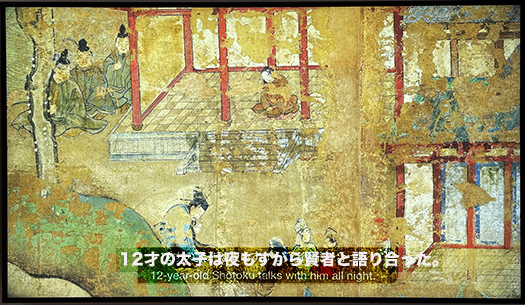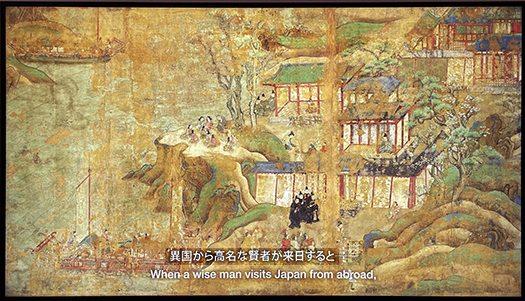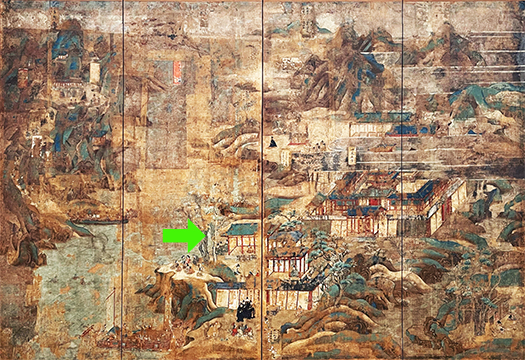


聖徳太子12才・583年のとき、来日していた百済国の高級官僚・日羅さんが偶然太子を見かけて、問答に及び、夜も更けるまで知的問答を繰り広げたとされるシーン。5隻10幅の「聖徳太子絵伝」壁画の第5隻の左下に記事配置されている。単純に太子の知的好奇心の発露の事例とされてきている。
この5隻には隋に派遣された大使である小野妹子が中国の衡山に出向き、太子の前世の持経を探したシーンや、太子が青龍車(祭りで使われる山車の一種だけれど、たぶん空想上の飛行高速移動手段)に乗って、前世での衡山で持っていた経文を取りに行くシーンなど、海外関係の事跡が集められたなかにある。
この日羅さんという人物も謎めいていて面白く、調べてみると「6世紀朝鮮半島にあった国家・百済の王に仕えた日本人、あるいは倭系百済官僚。父は肥後国の国造〜くにのみやっこ」というWiki記述が出てくる。この飛鳥時代当時では朝鮮半島国家と九州地域とはきわめて相関的な関係であったことが示されている。ヤマト王権の大和地域とも九州は相対的に異なった独自の認識・世界観を持っていたことが容易に想像できる。
さらに「日本書紀583年の条には敏達天皇の要請により来日して対朝鮮政策について朝廷に奏上。民を安んじ富ましめ国力を充実したうえで船を連ねて威を示せば百済は帰服するであろうことや、百済が九州に領土拡大を謀っているので防御を固め欺かれぬようにすべきことなど、百済に不利で機密性の高い情報交換内容だったとされる。その結果運命が暗転し同年12月に百済国役人らによって難波で暗殺された。」という国家安保上のトップシークレット案件も記されている。
高官が交流する関係でありながら、それはそのままスパイ活動である実態も明らかになっている。史実としては聖徳太子と話し込んだ年の年末に暗殺されているのだ。あるいはこの聖徳太子との密談に尾ひれがついて、国家の極秘情報の漏洩を怖れた百済関係者が刺客を送ったのかも知れない。
12才とはいえ、聖徳太子は国家主権者としての超英才だったことはあきらか。知的好奇心は旺盛でこういった立場の人物との会話は刺激に満ちた内容だったに違いない。そもそも「たまたま見かけた」から夜更けまで密談に及ぶのも奇異。会話内容の奥底を慎重に反芻しながら、深く興奮しつつ国益的な判断を迫られる怜悧な情報交換と推察できる。
こういった海外との機微な事情についても深い関心を持って思考訓練を重ねていたのだろうか。「もし万が一百済と日本が戦ったときにどういうことが起こり得るのか」リアリティに満ちた想像力を養っていたと言える。少なくとも仏教導入に身命を捧げた聖人君子という聖徳太子像とはかなり違和感のあるなまなましい現実政治家の実像がそこからは読み取れる。
後に「日出ずる処の・・・」というギリギリの国益追求リアリズム外交を実践する人物の本来の素性があらわれたエピソードか。こうした清濁を併せ持つ人物だからこそ、平和な国際関係を構築し得たのだとも思える。鎮護国家という仏教受容政策は日本の国体の基本として完全に根付き、その基本骨格を導入した政治指導者・聖徳太子への日本の民の評価は信仰にまで昇華した。かれのこうした政治家としての先見性・才能への民の側の評価も奥深く巨大だったのだと気付かされる。
English version⬇
The 12-year old prince secretly talks with a Baekje official (double agent?) The Gallery of Horyuji Treasures-5
A scene from a picture biography gives us a glimpse of diplomacy in those days. The actual situation of exchanging information with a high-ranking official of Baekje, Korea, although he was Japanese. The scene of a secret conversation with a spy
This is the scene in the lower left of the fifth panel of the “Shotoku Taishi E biography” mural painting, which consists of 10 panels in 5 panels, and is located in the lower left corner. It has been regarded simply as an example of the Taishi’s outburst of intellectual curiosity.
In these five paintings, there is a scene in which Ono Imoko, an ambassador dispatched to Sui Dynasty China, goes to Hengshan in China to search for the sutra of the Taishi’s previous life, and another scene in which the Taishi rides on a blue dragon cart (a kind of float used in festivals but probably an imaginary high-speed flying vehicle) to retrieve a sutra he had at Hengshan in his previous life. The person named Mr. Hira is also a mystery.
This character, Hira, is also mysterious and interesting, and when I looked him up, I found that he was “a Japanese or Japanese Baekje official who served the king of Baekje, a state on the Korean peninsula in the 6th century. His father was Kuninomiyakko, the king of Higo Province,” according to Wiki. The Asuka period shows that the relationship between the Korean peninsula state and the Kyushu region was highly correlated. It is easy to imagine that Kyushu had a unique perception and worldview that was relatively different from that of the Yamato kingdom’s Yamato region.
In addition, “In the 583rd year of the Chronicles of Japan, he came to Japan at the request of Emperor Toshitatsu to report to the Imperial Court on the policy toward Korea. It is said that the exchange of information was highly confidential and disadvantageous to Baekje, and included such matters as the fact that Baekje would be likely to surrender if the people were made comfortable and wealthy and the national power was strengthened, and that Baekje was planning to expand its territory to Kyushu, so the defenses should be strengthened to avoid being deceived. As a result, his fate took a dark turn and he was assassinated in Namba by Baekje officials in December of the same year. The article also contains a top-secret matter on national security, “The Baekje State was the first country in the world to exchange information on the Baekje Dynasty.
The fact that the relationship between the two countries was one of high official exchange and espionage is also revealed. The historical fact is that he was assassinated at the end of the year in which he talked with Prince Shotoku. Or, the secret talk with Prince Shotoku may have been traced back to him, and Baekje officials, fearing the leakage of top-secret national information, may have sent assassins to kill him.
It is clear that Prince Shotoku, although only 12 years old, was a super genius as a sovereign ruler of a nation. His intellectual curiosity was vigorous, and his conversation with a person in such a position must have been full of stimulation. It is also odd that they had a secret conversation late into the night because they “just happened to see each other. It can be inferred that it was a wise exchange of information that forced him to make a decision in the national interest while carefully ruminating on the depths of the conversation and becoming deeply excited.
I wonder if he was deeply interested in and trained to think about such sensitive matters with foreign countries. It can be said that they were cultivating their imagination filled with reality, wondering what might happen if Baekje and Japan fought each other. At the very least, we can read from this image of Prince Shotoku as a gentle and realistic politician, which is quite different from the image of Prince Shotoku as a saintly prince who devoted his life to the introduction of Buddhism.
This episode may have revealed the true nature of the man who later practiced realist diplomacy in pursuit of the national interest at the very last minute, as in “The place where the sun rises…”. It is precisely because he was a man who possessed both purity and turbidity that he was able to build peaceful international relations. The policy of accepting Buddhism as the foundation of Japan’s national identity as a state that protects and defends the nation has taken root in Japan, and the Japanese people’s appreciation of Prince Shotoku, the political leader who introduced this basic framework, has risen to the level of religious faith. We are reminded that the people’s appreciation of Shotoku Taishi’s foresight and talent as a statesman was also profound and enormous.
Posted on 6月 2nd, 2023 by 三木 奎吾
Filed under: 日本社会・文化研究, 歴史探訪







コメントを投稿
「※誹謗中傷や、悪意のある書き込み、営利目的などのコメントを防ぐために、投稿された全てのコメントは一時的に保留されますのでご了承ください。」
You must be logged in to post a comment.